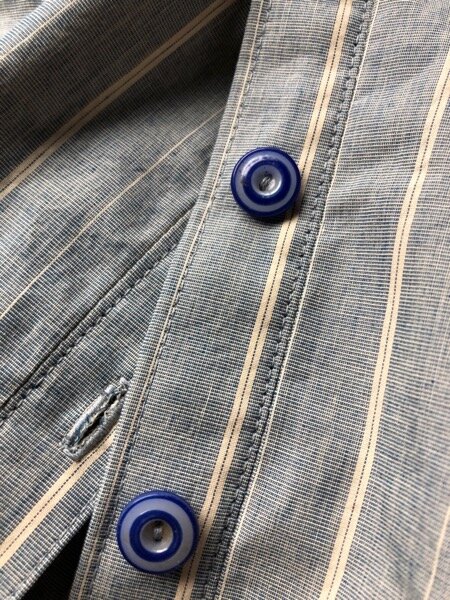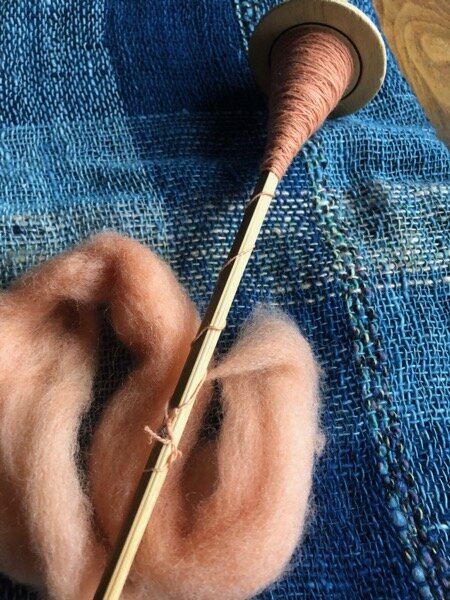So why all this knitting and spinning and weaving and sewing and stuff? Well yes, handmade clothes and fabrics are wonderful, but the truth is, many of us do this because we love handling the materials. Fiber, yarn, and cloth are sources of discovery and wonder, and so we’re forever coming up with new ways to explore with them and through them.
Ending up with reliable results is a sign that we are gaining in knowledge and skill, but getting there is often most of the fun - including the dreaming stage, the beholding of some material that compels us, either ineffably or viscerally. The Japanese shirting was doing that to me. Both the ochre version from which I made my petticoat, and this striped blue and neutral. They kept talking to me, insistently, requiring that I pay attention to them. I realized the striped one reminded me of indigo and persimmon, natural dye colors that are commonly seen in Japanese textiles.
I bought a remnant, again (when I can’t think of a concrete project for a fabric, I wait for it to be a remnant, then bring it home as a pet.) This sat in my basket, on view, for a while. Here it is with a Japanese indigo dyed piece my husband bought me while we lived in Japan (late 1990’s). It is loosely woven asa fabric - asa is a generalized term for native plant fibers, from what I can tell. The base yarn is colored with persimmon (kaki) and overdyed with indigo, in a way that involves folding and dipping.
Striped Japanese shirting and indigo/persimmon dip-dyed plant fiber cloth, detail.
Large scarf made of plant fiber dip-dyed with tapered horizontal stripes of indigo in alternating light and dark tones. Creased from being folded….
I found that I had enough for a sleeveless bodice, and began looking for a skirt. Enter one more beloved Thai sarong. This is apparently the year for me to use my Thai sarong fabrics. I wore this one quite a bit. It was a functional garment already, and had been sewn into a tube. When I put it next to the Japanese shirting and knew they belonged together, it struck me that this fabric also had a natural dye referent - it reminds me of madder and indigo. It’s not even a true batik, just a print, but I suspect that people dye and print commercial fabrics with colors that are traditionally pleasing, consciously or unconsciously hearkening back to natural dyes.
Print sarong, showing underside. Intricate batik-style patterns in shades of pink/brown and indigo blue, with black and white highlights.
Button band of sewn bodice, with 19th century China buttons in blue and white. These are my first machine sewn buttonholes, ever.
I don’t have to go far to find examples of madder and indigo among my fibers and fabrics. They are my favorites, and make their way into the stash with ease.
Madder-dyed wool spinning in progress, on a Peruvian spindle. I dyed the fiber in a workshop with Local Color Fiber Studio of Bainbridge Island. The weaving underneath I made with my rigid heddle loom, two shades of indigo cotton from Laos.
Working with these colors and fabrics is the joyful part - placing them next to each other, seeing how they communicate and what they have to tell me. Being able to wear what I make with the fabric, practicality meets delight. I made a sleeveless Hinterland dress which may serve as an undergarment until it gets warm out again.
Detail of dress, Japanese striped shirting on top, China buttons, Thai sarong on the bottom. Soothing blue and muddy cinnamon….
Another example of persimmon (painted onto stencil paper for use in stitch resist dyeing) and indigo (handmade paper made and dyed by Laura Mayotte.)
Natural colored flax yarn, spun by me, indigo dyed hemp yarn from Rainshadow Fibers, a Japanese bag made from plant fiber and dyed with indigo and possibly persimmon, but maybe walnut, underneath.
I’ve done that thing again, where I write about another topic and put it on a different page. Still thematic to the textile riches of my life, a contemplation of a camel trapping in the threads page.








